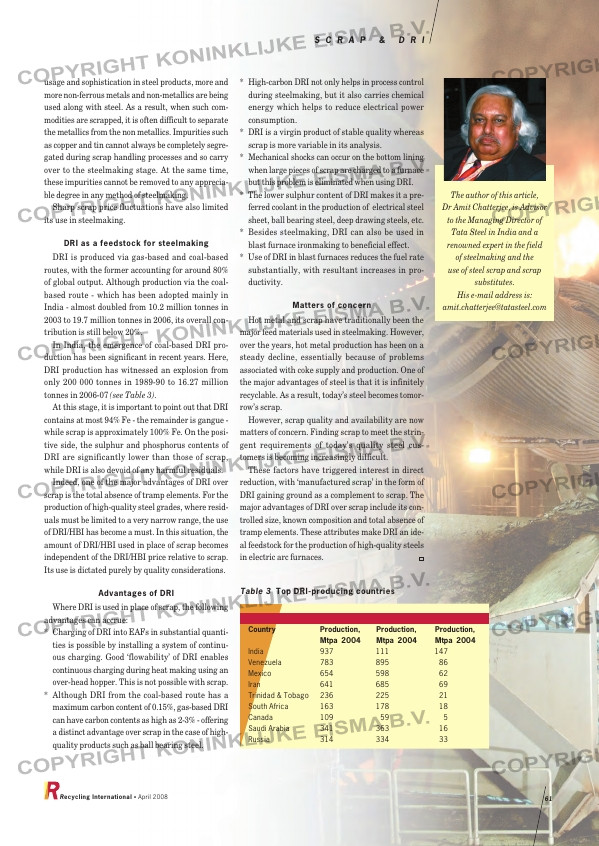Page 61 from: April 2008

usage and sophistication in steel products, more and
more non-ferrous metals and non-metallics are being
used along with steel. As a result, when such com-
modities are scrapped, it is often difficult to separate
the metallics from the non metallics. Impurities such
as copper and tin cannot always be completely segre-
gated during scrap handling processes and so carry
over to the steelmaking stage. At the same time,
these impurities cannot be removed to any apprecia-
ble degree in any method of steelmaking.
Sharp scrap price fluctuations have also limited
its use in steelmaking.
DRI as a feedstock for steelmaking
DRI is produced via gas-based and coal-based
routes, with the former accounting for around 80%
of global output. Although production via the coal-
based route – which has been adopted mainly in
India – almost doubled from 10.2 million tonnes in
2003 to 19.7 million tonnes in 2006, its overall con-
tribution is still below 20%.
In India, the emergence of coal-based DRI pro-
duction has been significant in recent years. Here,
DRI production has witnessed an explosion from
only 200 000 tonnes in 1989-90 to 16.27 million
tonnes in 2006-07 (see Table 3).
At this stage, it is important to point out that DRI
contains at most 94% Fe – the remainder is gangue –
while scrap is approximately 100% Fe. On the posi-
tive side, the sulphur and phosphorus contents of
DRI are significantly lower than those of scrap,
while DRI is also devoid of any harmful residuals.
Indeed, one of the major advantages of DRI over
scrap is the total absence of tramp elements. For the
production of high-quality steel grades, where resid-
uals must be limited to a very narrow range, the use
of DRI/HBI has become a must. In this situation, the
amount of DRI/HBI used in place of scrap becomes
independent of the DRI/HBI price relative to scrap.
Its use is dictated purely by quality considerations.
Advantages of DRI
Where DRI is used in place of scrap, the following
advantages can accrue:
* Charging of DRI into EAFs in substantial quanti-
ties is possible by installing a system of continu-
ous charging. Good ‘flowability’ of DRI enables
continuous charging during heat making using an
over-head hopper. This is not possible with scrap.
* Although DRI from the coal-based route has a
maximum carbon content of 0.15%, gas-based DRI
can have carbon contents as high as 2-3% – offering
a distinct advantage over scrap in the case of high-
quality products such as ball bearing steel.
* High-carbon DRI not only helps in process control
during steelmaking, but it also carries chemical
energy which helps to reduce electrical power
consumption.
* DRI is a virgin product of stable quality whereas
scrap is more variable in its analysis.
* Mechanical shocks can occur on the bottom lining
when large pieces of scrap are charged to a furnace
but this problem is eliminated when using DRI.
* The lower sulphur content of DRI makes it a pre-
ferred coolant in the production of electrical steel
sheet, ball bearing steel, deep drawing steels, etc.
* Besides steelmaking, DRI can also be used in
blast furnace ironmaking to beneficial effect.
* Use of DRI in blast furnaces reduces the fuel rate
substantially, with resultant increases in pro-
ductivity.
Matters of concern
Hot metal and scrap have traditionally been the
major feed materials used in steelmaking. However,
over the years, hot metal production has been on a
steady decline, essentially because of problems
associated with coke supply and production. One of
the major advantages of steel is that it is infinitely
recyclable. As a result, today’s steel becomes tomor-
row’s scrap.
However, scrap quality and availability are now
matters of concern. Finding scrap to meet the strin-
gent requirements of today’s quality steel cus-
tomers is becoming increasingly difficult.
These factors have triggered interest in direct
reduction, with ‘manufactured scrap’ in the form of
DRI gaining ground as a complement to scrap. The
major advantages of DRI over scrap include its con-
trolled size, known composition and total absence of
tramp elements. These attributes make DRI an ide-
al feedstock for the production of high-quality steels
in electric arc furnaces.
S C R A P & D R I
Recycling International • April 2008 61
The author of this article,
Dr Amit Chatterjee, is Advisor
to the Managing Director of
Tata Steel in India and a
renowned expert in the field
of steelmaking and the
use of steel scrap and scrap
substitutes.
His e-mail address is:
[email protected]
Table 3 Top DRI-producing countries
Country Production, Production, Production,
Mtpa 2004 Mtpa 2004 Mtpa 2004
India 937 111 147
Venezuela 783 895 86
Mexico 654 598 62
Iran 641 685 69
Trinidad & Tobago 236 225 21
South Africa 163 178 18
Canada 109 59 5
Saudi Arabia 341 363 16
Russia 314 334 33
RI_044 Scrap & DRI:Opmaak 1 03-04-2008 15:27 Pagina 61



